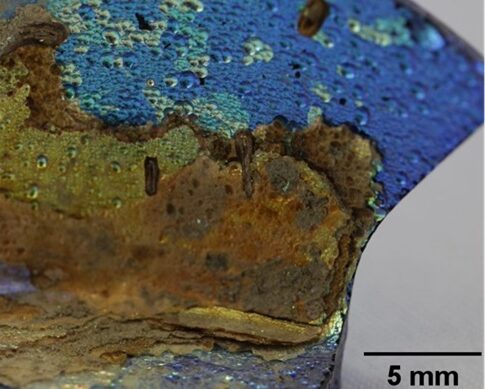From Roman Relics to Radiant Realms | How Roman Glass Reveals the Secrets of Photonic Crystals in Today’s Science
 A piece of Roman glass found in the ancient city of Aquileia has undergone a chemical transformation over two millennia, turning it into a photonic crystal. This transformation resulted in a nanostructured surface that reflects light in a way similar to a butterfly’s wings. The glass shard, discovered in 2012, displays an iridescent surface of deep blue and shiny gold atop a substrate of dark green.The shard’s chemical and physical properties were examined by Giulia Guidetti of Tufts University and her team. They found that the glass’s coloration and structure were the result of a chemical transformation of the amorphous glass into a nanolayered material. The glass was likely made between 100 BCE and 100 CE, with its dark green color resulting from the use of vegetable ash as a reducing agent during its creation. The blue and gold colors, however, appeared later as a result of the degradation process.
A piece of Roman glass found in the ancient city of Aquileia has undergone a chemical transformation over two millennia, turning it into a photonic crystal. This transformation resulted in a nanostructured surface that reflects light in a way similar to a butterfly’s wings. The glass shard, discovered in 2012, displays an iridescent surface of deep blue and shiny gold atop a substrate of dark green.The shard’s chemical and physical properties were examined by Giulia Guidetti of Tufts University and her team. They found that the glass’s coloration and structure were the result of a chemical transformation of the amorphous glass into a nanolayered material. The glass was likely made between 100 BCE and 100 CE, with its dark green color resulting from the use of vegetable ash as a reducing agent during its creation. The blue and gold colors, however, appeared later as a result of the degradation process.
Further examination of the shard revealed structures on several length scales. At the largest scale, micrometer-wide concave domains are randomly distributed over the surface. Parallel to the surface are thousands of thin layers, mostly made of silica, that alternate in density and refractive index between high and low. The thickness of these layers decreases from 320 to 90 nm as the distance from the outer surface increases.
This layered structure is similar to that of an artificial photonic crystal, where the refractive index varies periodically on a length scale comparable to the wavelength of light. This periodicity creates interference effects that cancel some wavelengths from being reflected back out of the crystal, giving white light that enters a photonic crystal color on its way out. The shiny gold and deep blue colors of the shard are due to these interference effects, which depend on the wavelength and the angle at which light reflects off the surface.
The pH of the soil surrounding the shard played a crucial role in this transformation. Glass resists acids, but when subjected to highly alkaline solutions, the hydroxyl ions react with the glass’s silicon atoms, dissolving the surface to form pits. This dissolution also occurs in mildly alkaline solutions, but at a slower pace, allowing silicon and oxygen atoms to reprecipitate and form nanoparticles. These nanoparticles then assembled into layers, creating the photonic crystal structure observed in the shard.
Key Takeaways:
- A two-thousand-year-old fragment of Roman glass has transformed into a photonic crystal due to a chemical transformation that occurred as the glass lay buried, resulting in a nanostructured surface which reflects light in a similar way to a butterfly’s wings.
- The glass shard, discovered in the ancient Roman city of Aquileia, has a unique coloration of deep blue and shiny gold atop a dark green substrate, which is believed to have occurred as a result of the degradation process, not from the original glassmaking process.
- The pH of the soil in which the shard was buried played a crucial role in its transformation, as the alkaline solutions reacted with the glass’s silicon atoms, slowly dissolving the surface to form pits and allowing silicon and oxygen atoms to reprecipitate and form nanoparticles.
“Now, after subjecting the shard to a string of chemical and physical tests, Giulia Guidetti of Tufts University, Massachusetts, and her collaborators have identified the origin of the shard’s appearance: a chemical transformation of the amorphous glass into a nanolayered material, a photonic crystal.”
More details: here

Leave a Reply